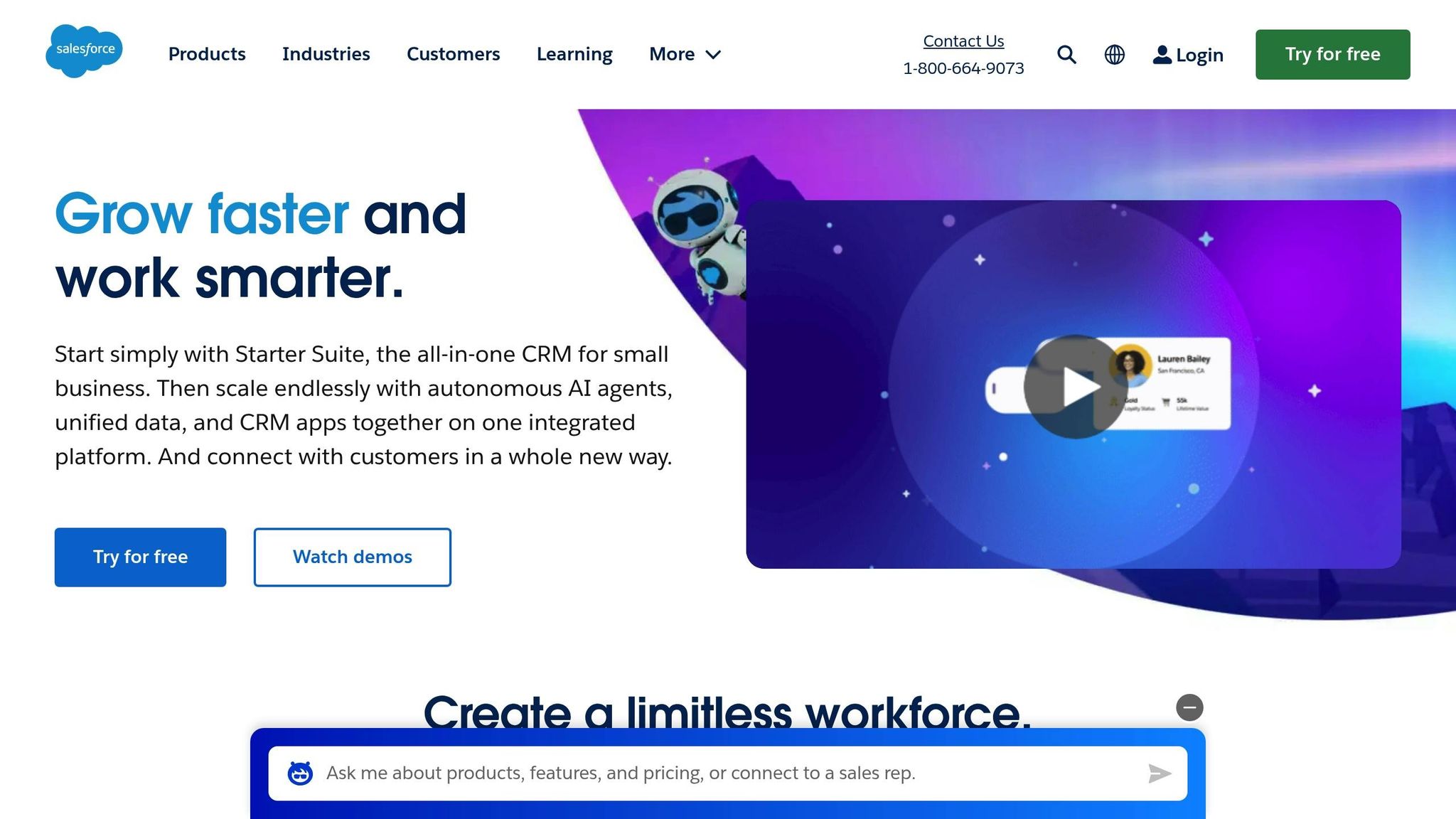Looking for the right CRM? Here’s a quick breakdown of Salesforce and HubSpot to help you decide:
- Salesforce: Best for large enterprises needing deep customization, advanced analytics, and complex sales processes. Offers extensive tools like territory management, AI-driven forecasting, and over 3,000 integrations through AppExchange. Requires more setup and technical expertise.
- HubSpot: Perfect for small to medium-sized businesses focused on marketing and sales alignment. Known for its user-friendly interface, built-in marketing tools, and quick setup with minimal training. Includes a free plan with essential features.
Quick Comparison
| Feature | Salesforce | HubSpot |
|---|---|---|
| Customization | Extensive | Limited to predefined settings |
| Ease of Setup | Requires technical expertise | Quick and user-friendly |
| AI Tools | Advanced, customizable | Simple, built for accessibility |
| Pricing | Tiered, higher costs, add-ons | Freemium, predictable upgrades |
| Best For | Enterprises, complex workflows | SMBs, marketing-driven teams |
Key Takeaway:
Choose Salesforce for scalability and customization. Go with HubSpot for simplicity and integrated marketing tools. Your decision should align with your team’s size, technical skills, and business goals.
Salesforce vs HubSpot (2024) 🤝

Core Features Comparison
Salesforce and HubSpot each bring distinct strengths to the CRM landscape.
What Salesforce Offers
Salesforce provides enterprise-level CRM tools with extensive options for tailoring the platform to fit specific business needs. Key features of the Sales Cloud include:
- Contact Management: Detailed customer profiles with custom fields and dynamic records.
- Pipeline Management: Flexible sales stages and tools for tracking opportunities.
- Territory Management: Assign sales territories based on geography or accounts.
- Forecasting Tools: AI-driven sales predictions and trend analysis.
- AppExchange Integration: Access to over 3,000 third-party apps and integrations.
This level of customization allows businesses to create tailored workflows. For instance, a manufacturing company could track product specifications, warranty information, and service history all within the system.
What HubSpot Offers
HubSpot emphasizes simplicity and seamless integration with marketing tools. Its standout features include:
- Contact Management: Visual timelines for tracking customer interactions.
- Deal Pipeline: Drag-and-drop functionality for managing deal progress.
- Marketing Tools: Built-in options for email campaigns, landing pages, and forms.
- Meeting Scheduler: Easy appointment booking with calendar integration.
- Document Management: A content library with tracking and analytics.
HubSpot’s intuitive interface ensures faster adoption, making it ideal for teams that need a straightforward system. The platform also includes built-in content creation tools, enabling sales teams to produce and share materials without juggling multiple applications.
Here’s a side-by-side comparison of key features:
| Feature | Salesforce | HubSpot |
|---|---|---|
| Customization | Extensive options | Limited to predefined settings |
| Contact Records | Complex, hierarchical relationships | Simple timeline view |
| Pipeline Management | Multi-stage workflows with branching | Linear deal stages |
| Email Integration | Requires setup | Native plugins for Gmail/Outlook |
| Reporting | Advanced, custom reports | Pre-built, easy-to-use dashboards |
Both platforms offer mobile apps, but their focus differs. Salesforce’s app replicates the full desktop experience, while HubSpot’s app simplifies essential tasks like logging calls and updating deals.
Ultimately, the decision between these platforms depends on your business’s needs. Salesforce is better suited for companies requiring deep customization and scalability, while HubSpot is ideal for teams prioritizing quick setup and ease of use. Next, we’ll explore how these platforms handle AI and automation tools.
AI and Automation Tools
Both platforms use AI to simplify sales processes and improve productivity, but their methods differ.
Salesforce AI Tools
Salesforce Einstein AI focuses on automation and predictive analytics in three main areas:
Predictive Lead Scoring
- Scores leads based on past interactions.
- Analyzes a wide range of behavioral signals.
- Updates scores in real time as prospects interact.
Sales Process Automation
- Automatically assigns leads using custom rules.
- Creates follow-up tasks automatically.
- Suggests next steps for sales representatives.
Advanced Analytics
- Examines sales patterns to predict deal closings and identify the best times to reach out.
- Detects trends in successful sales strategies.
Einstein Activity Capture reduces manual data entry by logging emails and calendar events. It also offers AI-driven insights to help sales teams focus on deals that need extra attention.
HubSpot AI Tools
HubSpot’s AI tools are built to make automation accessible and practical for teams of any size, emphasizing ease of use:
Smart Content Tools
- Customizes website content based on visitor behavior.
- Adjusts email messaging to match recipient preferences.
- Creates dynamic lists based on engagement trends.
Predictive Lead Scoring
- Scores leads using both firmographic and behavioral data.
- Continuously updates scores as new interactions occur.
Conversation Intelligence
- Analyzes sales calls to highlight important topics.
- Identifies patterns in successful conversations.
- Pinpoints coaching opportunities for sales teams.
HubSpot also offers content suggestions, analyzing top-performing trends to recommend topics and formats likely to resonate with prospects.
Here’s a side-by-side comparison of their AI features:
| AI Feature | Salesforce | HubSpot |
|---|---|---|
| Lead Scoring | Advanced scoring with custom model options | Pre-built scoring models with basic tweaks |
| Automation | High-level workflow automation | Easy-to-use automation templates |
| Setup Complexity | Requires extensive training and longer setup | Quick setup with minimal training |
| Customization | Fully customizable AI rules | Customization through predefined templates |
Next, explore the setup processes and learning curves for these platforms.
sbb-itb-0ae5139
Setup and Learning Curve
The setup process and learning curve differ significantly between the two platforms, depending on your technical expertise and the time you can dedicate.
Getting Started with HubSpot
HubSpot is built for a straightforward setup that users can handle on their own. It offers:
- Quick Start Process
Includes step-by-step tutorials for core features, visual workflow builders for easier configuration, and ready-to-use templates for common business needs. - Data Migration Tools
Features import wizards to transfer CSV data, automated field mapping, and built-in tools for cleaning and validating data in real-time. - Training Resources
Access to free HubSpot Academy courses, in-app guidance, and community forums for peer support.
Getting Started with Salesforce
Salesforce setup requires more detailed planning and technical involvement. Here’s what to expect:
- Implementation Process
A structured setup process that often requires dedicated administrative and IT support for configuration. - Required Resources
Typically involves a certified Salesforce administrator and possibly a development team for custom integrations. Specialists in change management and training may also be needed for a smooth rollout. - Technical Considerations
Includes configuring permission settings, custom fields, and workflow rules. Advanced setups, like API integrations, often demand additional expertise.
Your choice should align with your team’s technical skills and timeline. HubSpot is ideal for those looking for a quick, user-friendly deployment, while Salesforce is better suited for businesses that need extensive customization and advanced integration options.
Cost Breakdown
Salesforce Plans and Costs
Salesforce pricing is structured across tiers, catering to small teams and large enterprises alike. As you move up the tiers, you gain access to features like workflow automation, advanced reporting, API access, and more customization options. Additional tools, such as AI-driven analytics, integrated marketing, and expanded service capabilities, are offered as optional add-ons for an extra charge. The total cost depends on factors like the number of users, the features you need, and your contract terms.
HubSpot Plans and Costs
HubSpot takes a different approach with its freemium pricing model. It offers a free CRM that includes essential tools like contact management and pipeline tracking. For businesses with more complex needs, HubSpot provides premium tiers that bundle tools for marketing, sales, and service. These higher tiers include features like advanced automation, detailed reporting, and tailored support.
When comparing these platforms, consider both the base pricing and the cost of any additional features. Think about your current needs and future growth to determine which pricing model works best for you.
Best Fits by Business Type
When to Choose Salesforce
Salesforce works well for large organizations with intricate sales processes. It’s particularly effective in scenarios such as:
- Global operations: Businesses spread across multiple regions or countries can benefit from features like territory management and multi-currency support.
- Extensive customization needs: Companies that require tailored workflows, custom objects, or specific automation tools.
- Advanced analytics: Organizations looking for detailed insights into sales performance, customer behavior, and market trends.
- Strict compliance requirements: Industries like healthcare, finance, or government that deal with heavy regulatory demands.
For example, a manufacturing company might use Salesforce to monitor product configurations, manage distributor relationships, and coordinate between sales and production teams.
When to Choose HubSpot
HubSpot is ideal for small to medium-sized businesses that focus on aligning marketing and sales. It’s a great choice for:
- Growth-focused startups: Companies looking for a platform that can scale as they grow.
- Digital-first companies: Businesses prioritizing content marketing, social media, and digital campaigns.
- B2B service providers: Agencies, consultancies, and professional service firms that benefit from integrated tools.
- Marketing-driven organizations: Companies emphasizing inbound marketing and content strategies.
HubSpot is particularly effective for companies with 10–200 employees that need a unified approach to managing the customer journey across marketing and sales.
| Business Characteristic | Better Fit |
|---|---|
| Enterprise (1,000+ employees) | Salesforce |
| SMB (10–200 employees) | HubSpot |
| Complex sales cycles | Salesforce |
| Content marketing focus | HubSpot |
| High customization | Salesforce |
| Limited technical resources | HubSpot |
| Multi-department coordination | Salesforce |
| Digital marketing priority | HubSpot |
Making Your Choice
When deciding between these platforms, a few critical factors should guide you:
Budget and ROI
If you’re working with limited funds but need a strong CRM, HubSpot’s free tier is a great starting point. As your needs expand, HubSpot’s pricing tends to be more predictable compared to Salesforce’s tiered approach.
Implementation Timeline
Think about whether your business priorities lean toward quick deployment or more tailored customization. Your timeline and available resources will play a big role in this decision.
Technical Resources
Consider your team’s technical skills. HubSpot allows marketing and sales teams to manage tasks independently, while Salesforce often requires dedicated technical support to unlock its full potential.
Here’s a quick decision matrix to help narrow things down:
| Need | Choose |
|---|---|
| Quick deployment | HubSpot |
| Enterprise customization | Salesforce |
| Marketing automation | HubSpot |
| Complex sales processes | Salesforce |
| Content tools | HubSpot |
| Territory management | Salesforce |
The right platform should meet both your current needs and future goals. If you’re planning significant growth, Salesforce’s advanced capabilities might justify the higher costs and longer setup time. On the other hand, if digital marketing integration and CRM features are your focus, HubSpot’s all-in-one system could be the better fit.
Keep in mind, your choice isn’t set in stone. Both platforms offer flexibility, allowing you to adapt as your business grows. Focus on what fits your needs today while keeping an eye on future scalability.

